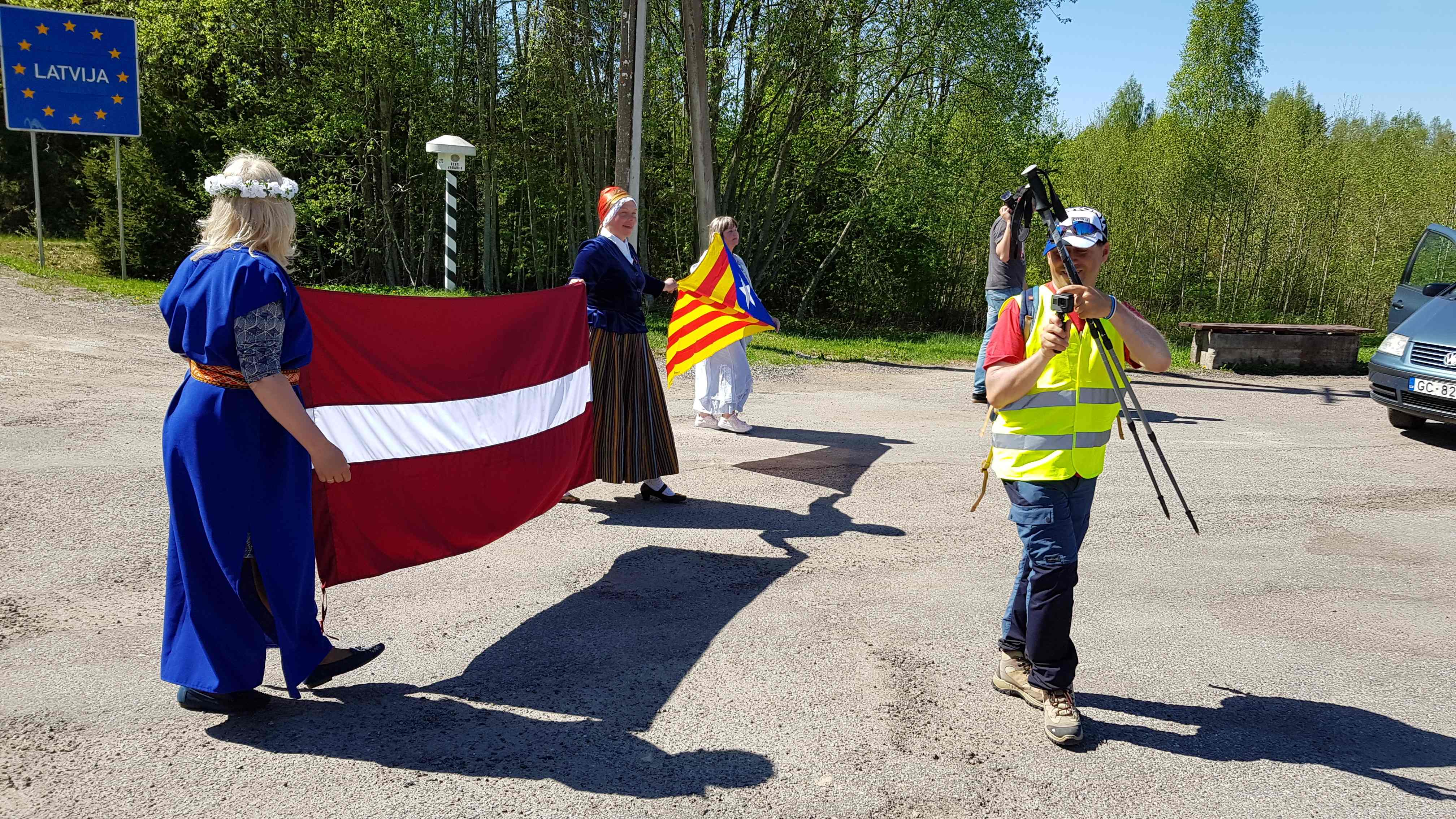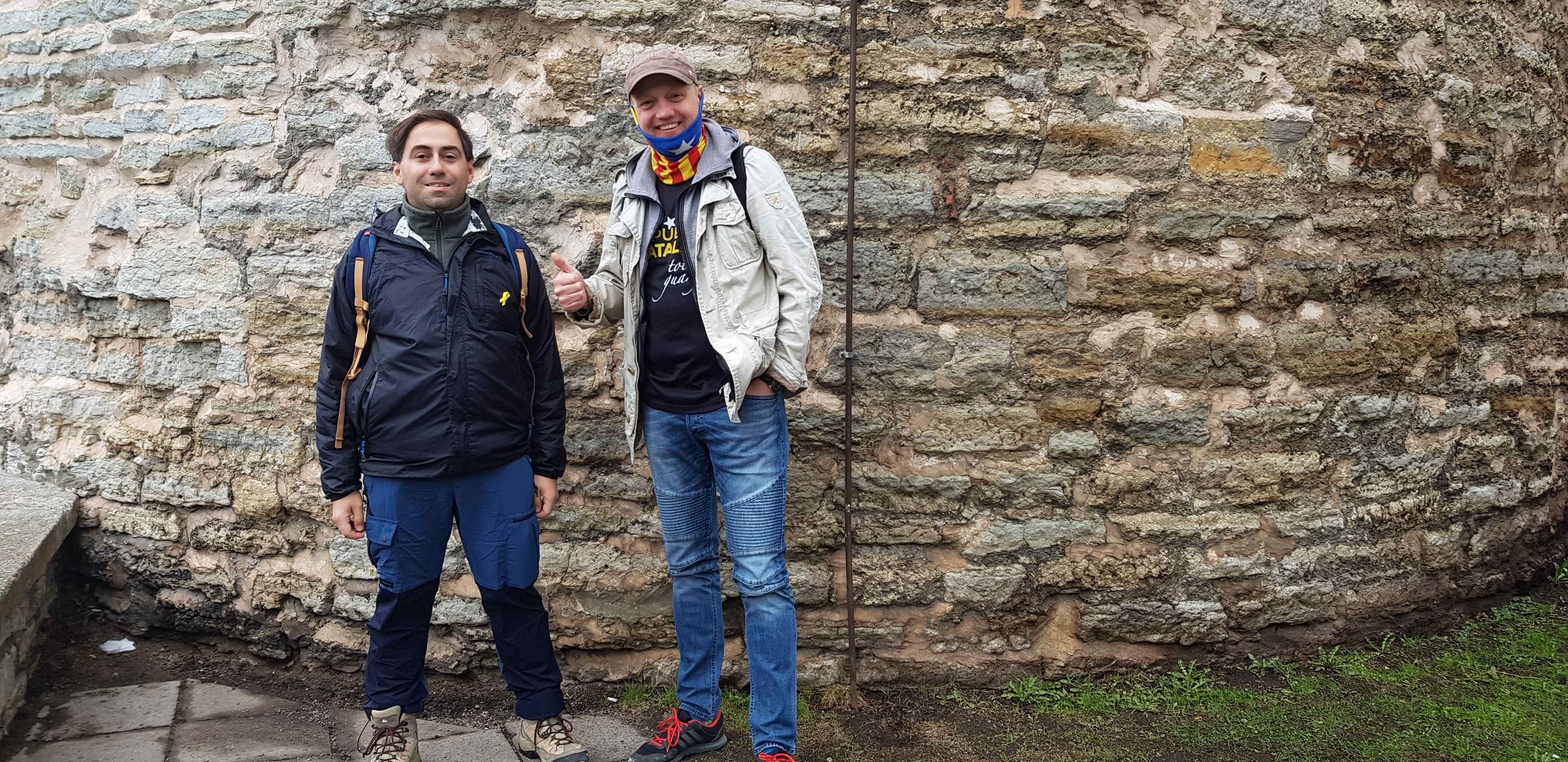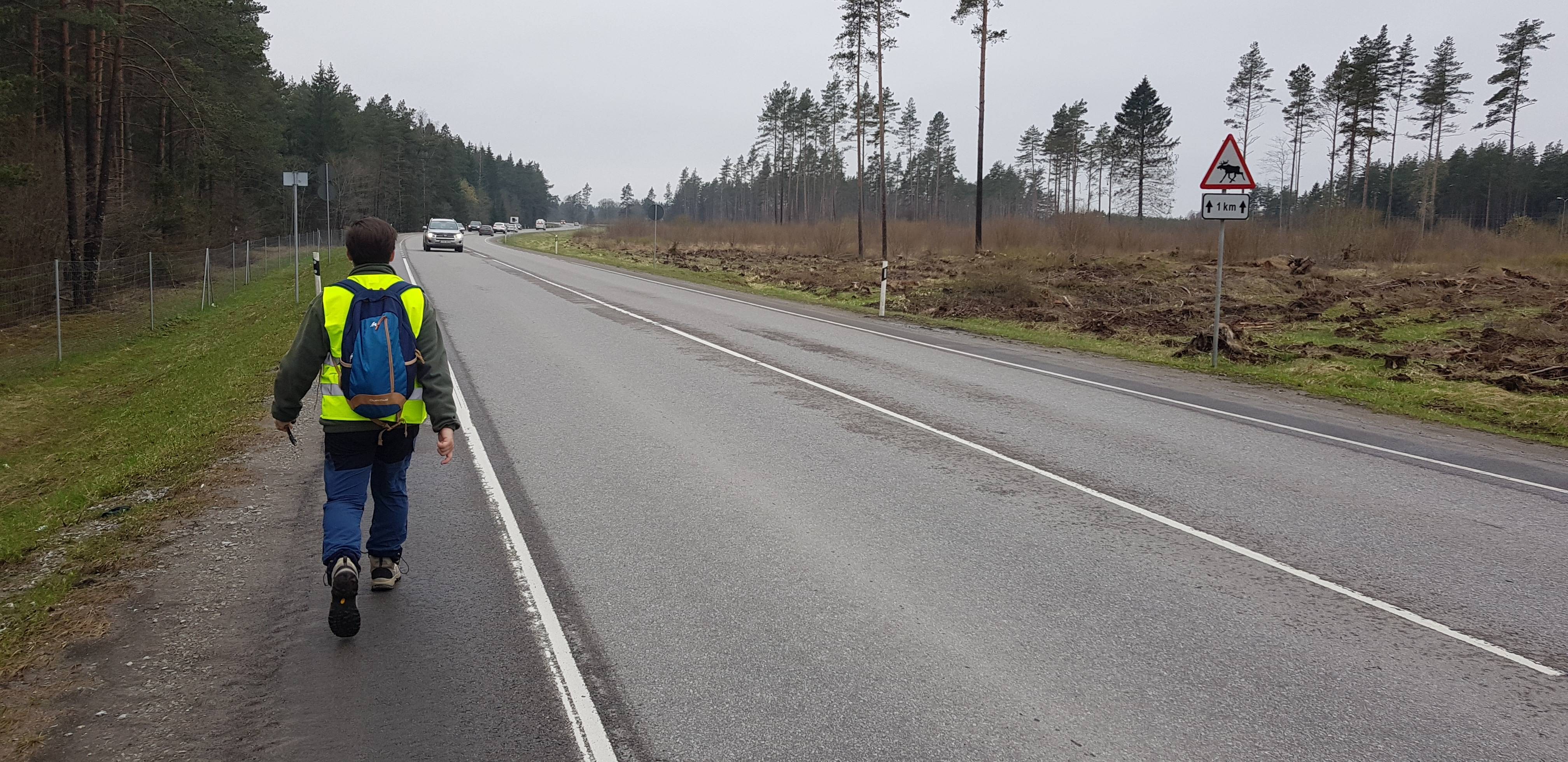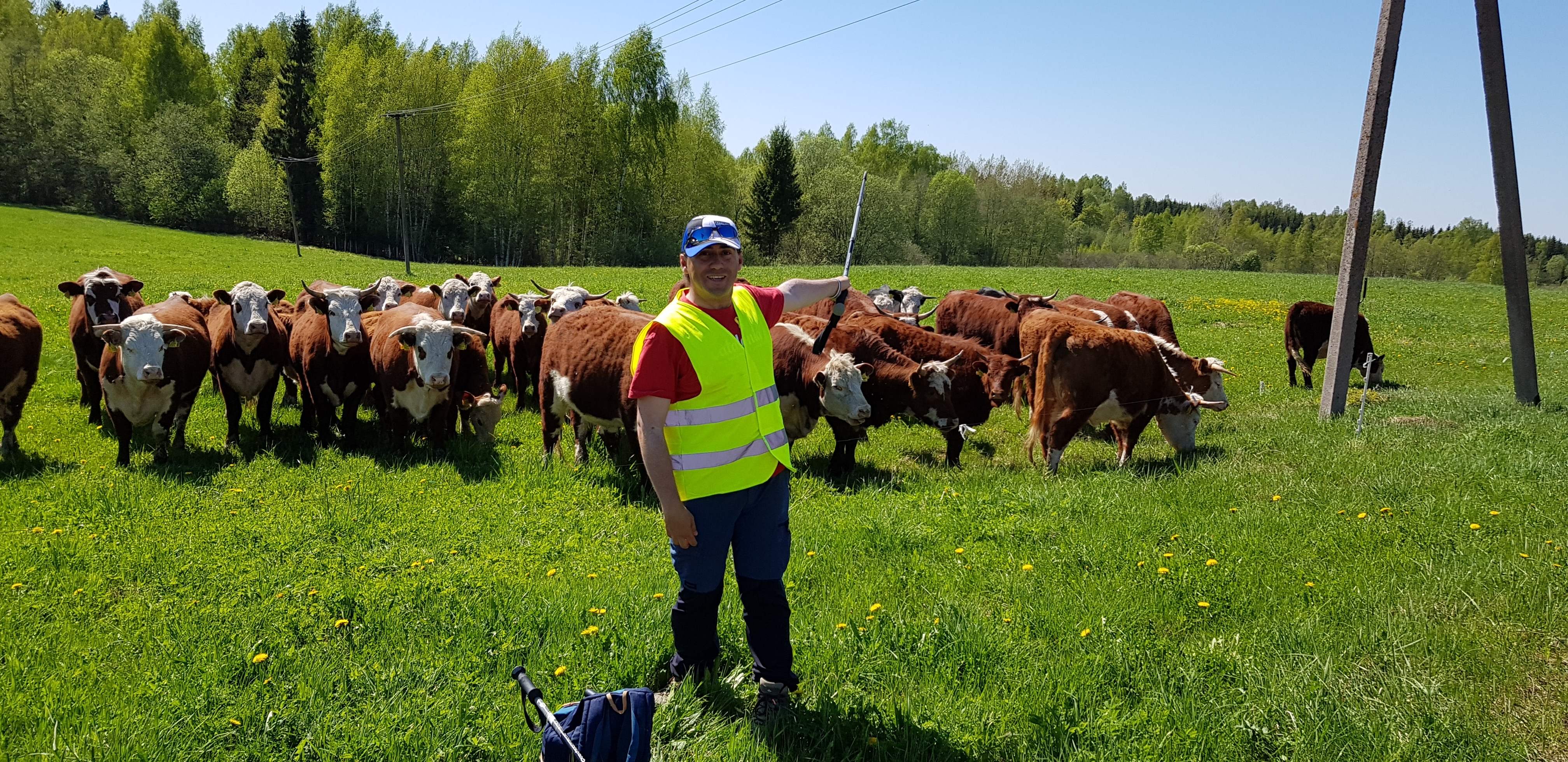19.06.2018 - 07:48
|
Actualització: 19.06.2018 - 09:48
VilaWeb interviews a man from southern Catalonia who is walking 700 km to show his gratitude for the involvement of many Latvians, Lithuanians and Estonians in the Catalan cause. On May 1 he left Tallinn (Estonia) and next week he will be ending his walk in Vilnius (Lithuania), having travelled the long distance that was covered by the Baltic Way participants twenty-nine years ago.
-You have been walking for over four weeks now and the end is near. How are you holding up?
-Better than I expected. The first few days are hard until you get into the rhythm of things, but it’s all downhill from then on. The main problem I have encountered, which I hadn’t anticipated, is the extreme heat wave that has hit central and northern Europe in May. This means that I am exhausted by the end of every day. But it’s nothing that plenty of water, sunblock and a good night’s rest won’t take care of.
-How did you come up with the ides of walking the Baltic Way?
-I had a job at Diplocat [the now-extinct Public Diplomacy Council of Catalonia]. I had a long time to think while we were waiting to be sacked, following the disproportionate application of direct rule [by the Spanish authorities]. So I decided that I would go on a long walking route before looking for a new job. During my five-year stint with Diplocat I had the chance to host a number of events in the Baltic countries to explain the Catalan people’s will to hold a referendum. I met some politicians, journalists, writers, academics and so on. All of them had shown a lot of interest in Catalonia and had taken it upon themselves to spread the word of the Catalan cause in their respective nations. Some did so discreetly and anonymously while others, like Otto Ozols, were totally open about it.
-We’ll come to Otto Ozols in a minute. So, if I’m understanding this right, what you are doing is meeting these people again and thanking them for what they’ve done for Catalonia?
-Yes. Obviously none of them asked for anything in return. I’m saying this for the benefit of those who claim that Diplocat used to go round buying international support across Europe. They should know that there are principles and values that are more appreciated than money. But somehow I wanted to return their selfless backing for Diplocat and Catalonia. At the end of the day, public diplomacy, what we used to do at Diplocat, is not just about bringing your narrative to others, but also listening to their own concerns and interests …

-And you thought of the 1989 Baltic Way.
-Yes. I recalled the great event that brought together the Baltic countries and Catalonia in 2013: the massive human chain of 1989. I thought that a walk along the Baltic Way must be a popular activity in the area, because I had noticed road signs during my trips there. Later I realised that I was wrong and I’ve had to work hard to sort out the logistics of securing accommodation in less populated areas, particularly in Estonia and Lithuania. Ultimately, it’s about walking for a cause. The Way of St. James first got started because of its religious and cultural interest. I am walking the Baltic Way because I believe in the cause of freedom and democracy, as the Baltic people did thirty years ago and still do today.
-How did you get ready for it? Have you ever walked the Way of St. James?
-I’ve done a third of it, from my home town Tortosa to the border between Aragon and Navarre. This previous experience showed me where my limit lies, mainly that I should avoid walking more than 35 km per day. I also learnt that I was fit enough to do a long trail. When I decided to follow the 1989 Baltic Way rather than return to the Way of St. James where I left off, I began to do 15-kilometre walks on flat ground in different parts of Catalonia because the Baltic countries are flat. Whenever possible, I walked on wet days, to get used to the weather which we were supposed to get this May in the Baltic region. For instance, I walked along the Barcelona coast, from Premià de Mar to La Barceloneta, and from El Prat de Llobregat to the beach of Castelldefels. I also walked parts of the two main green ways that we have in Catalonia, in the Ebre region and Girona.
-Earlier you mentioned Otto Zols. In April 2016 this Latvian journalist walked all 400 km of the Catalan Way. Is this your way of paying him pack?
-No doubt he had an influence on me. He has spent a long time explaining Catalonia in Latvia and I’m trying to explain the Baltic countries in Catalonia and everywhere else. In fact, during my hike I have been interviewing people of all ages who took part in the Baltic Way and I have been posting summaries of our interviews in English on Instagram. The story of the Baltic Way and the desire of the three countries to be free deserves to be heard and read, time and again, all over Europe. It’s not just an account of national independence, which undoubtedly is what interests Catalans the most, but also a story about the struggle for individual rights against a totalitarian regime which Catalan do not know well enough: the Soviet Union.

-How would you describe Otto Ozols to a complete stranger?
-Ozols is one of Catalonia’s best friends in the region and the best-known one in Latvia, for sure. He is an admirer of Lennart Meri, who was the president of Estonia, a country he also looks up to. Meri once said —and Ozols agrees with him— that there will be a growing number of independent countries in the world. It is a natural tendency which democratic countries cannot stem; all they can do is negotiate and find imaginative solutions. Ozols finds Spain’s reaction shocking, not just because it is a supposedly democratic country, but because the EU has decided not to intervene. Additionally, as a Latvian, Ozols is worried about Vladimir Putin’s attempts to destabilise Europe on the back of the EU’s double standards: Spain is praised while Poland gets punished. And this is the last thing that Latvians and the other Baltic peoples want to see.
-So far what’s been the best thing about the trail?
-The best thing has been meeting and getting to know the protagonists of the Baltic Way, not only the participants, but the organisers themselves. Also people who hadn’t been born yet back then, but somehow are involved in a project to do with those exciting years. Hearing their personal stories and learning from their experiences is the best memory I will keep with me.
-How do you go about chatting to people? Is it easy?
-It’s not as easy as it would seem! You must bear in mind that these countries are not densely populated and most people live in cities, whereas I spend most days walking on empty paths and roads. Besides, there is a language barrier, as not everyone speaks English and that is the language I rely on. But social networks are proving very helpful and many people have helped out by sharing the article I wrote about why I’m walking the Baltic Way. I also get in touch beforehand with local media and councils of the spots I will be passing through and many of them help me to get in touch with people who have a story to tell. Funnily enough, organisers and participants from central Estonia barely know the participants in the south of their country or the centre of Lithuania. So, somehow I am joining the dots again, twenty-nine years later.

-Any negative experiences worth mentioning?
-When I began my walk, my main concern was meeting one of the road-crossing bears in Estonia you can see on videos posted on social networks. Perhaps people make too big a deal of it, but I was worried until I realised that nobody else was, and I learned that bears had never caused any incidents. Also, I thought that the police would stop me for walking on a motorway near Riga, but that didn’t happen, either. As I said, the worst thing is the intense heat and the dust clouds in the air.
-Nearly thirty years after the Baltic Way, what is left of its driving spirit? Do young people know about it?
-Many of the key people are still alive and, believe me, they would be ready to put together something similar, if the need arose! Still, you must remember what the context was back then. Nowadays anyone who is dissatisfied merely packs their case and moves to another EU country. A bittersweet experience that I’ll take with me is the fact that many young people I spoke to do not realise the importance of what their parents did for their freedom. Of course, there are exceptions, as is to be expected.
-We always tend to think that the Baltic countries sympathise with the Catalan independence process. Is that really true?
-In part. Most people don’t know what is going on in Catalonia. This is hardly surprising. How many of us are aware of what is presently going on in the Baltic republics? We are all living in our own corner of Europe. However, those in the know (which must be about 40 per cent of the population) strongly support the Catalan process. You don’t even need to speak to them to find out: you just need to read the comments posted on digital media about news from Catalonia. I’d like to point out that I only speak about Catalonia when they ask me about it. I always introduce myself as a Catalan and, at the end of every interview, most people are keen to know how things are going in Catalonia.

-Are there any differences between Lithuania, Latvia and Estonia on that point?
-I hesitate to compare. I can say that support for Catalonia is much more visible in Latvia than in Lithuania and Estonia, because Twitter is so much more popular there. But that doesn’t mean that I haven’t encountered support in the other two countries.
-When news outlets interview you, as you mentioned earlier, what do they ask about?
-Local and regional papers in all three countries are keen to hear the reasons why I am doing this and especially how I sort things out and whether I get any help. They are also concerned about my safety. I am very grateful to the various local and regional papers I have spoken to during the trail, as they have been very helpful in finding the protagonists of the Baltic Way. More than once I’ve been asked about the yellow ribbon which I always wear [to indicate support for Catalonia’s political prisoners]. When I tell them what it means, they are gobsmacked.
-Do you intend to collect these experiences elsewhere, beyond the social networks?
-For now I have collected my interviews on Twitter and Instagram with the hashtag #BalticWayJordi. When I get back I’d like to write a book to pay tribute to the men and women who decided to rise in 1989, after over forty years of silence, to free their countries peacefully. It would also serve as a little travel guide for anyone who wishes to get to know the Baltic countries beyond the three capital cities, which is what most visitors stick to, unfortunately. I’d like to do that next year, which will be the 30th anniversary of the Baltic Way, but my experience as a writer is nil so if anyone can offer some advice, I’d be more than grateful. The story will be worth a read, that’s for sure!


